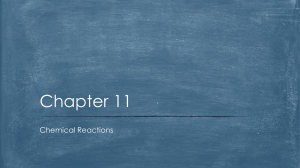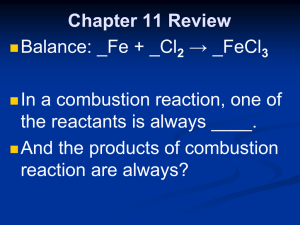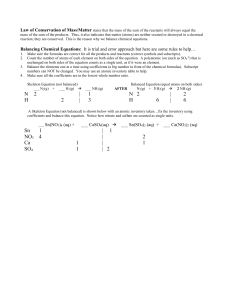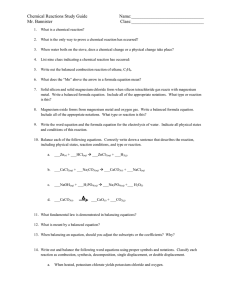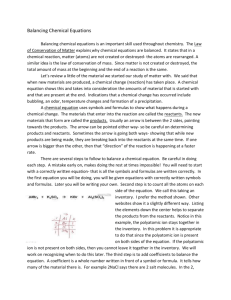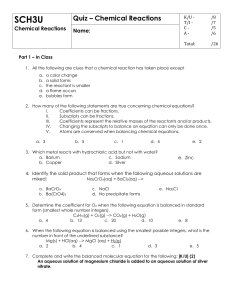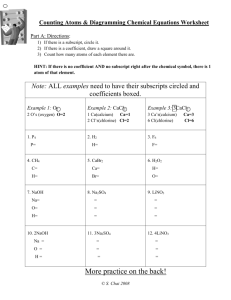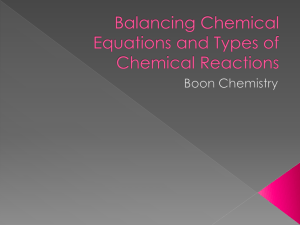rules for balancing chemical equations
advertisement
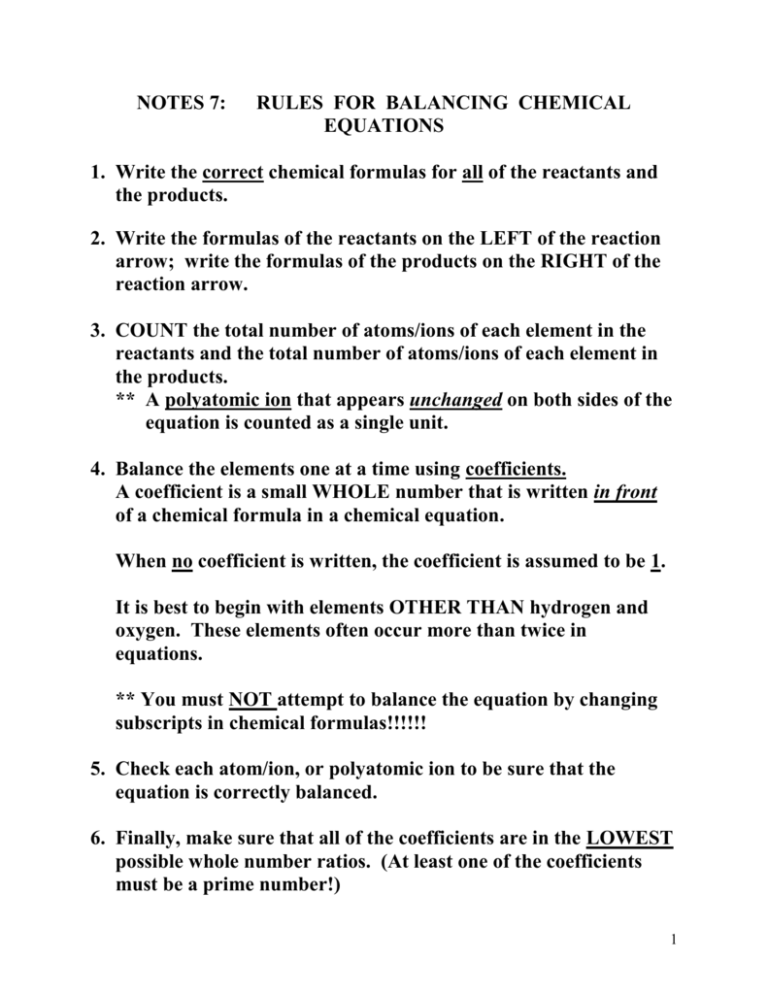
NOTES 7: RULES FOR BALANCING CHEMICAL EQUATIONS 1. Write the correct chemical formulas for all of the reactants and the products. 2. Write the formulas of the reactants on the LEFT of the reaction arrow; write the formulas of the products on the RIGHT of the reaction arrow. 3. COUNT the total number of atoms/ions of each element in the reactants and the total number of atoms/ions of each element in the products. ** A polyatomic ion that appears unchanged on both sides of the equation is counted as a single unit. 4. Balance the elements one at a time using coefficients. A coefficient is a small WHOLE number that is written in front of a chemical formula in a chemical equation. When no coefficient is written, the coefficient is assumed to be 1. It is best to begin with elements OTHER THAN hydrogen and oxygen. These elements often occur more than twice in equations. ** You must NOT attempt to balance the equation by changing subscripts in chemical formulas!!!!!! 5. Check each atom/ion, or polyatomic ion to be sure that the equation is correctly balanced. 6. Finally, make sure that all of the coefficients are in the LOWEST possible whole number ratios. (At least one of the coefficients must be a prime number!) 1 Example: When hydrogen and oxygen react, the product is water. Write the balanced chemical equation. (skeleton) H2 (g) + O2 (g) → H2O (l) 2H 2O 2H 1O ________________________________________ H2 (g) + O2 (g) → 2 H2O (l) 2H 2O 4H 2O _________________________________________ BALANCED: 2 H2 (g) + O2 (g) → 2 H2O (l) 4H 2 2O 4H 2O BALANCING CHEMICAL EQUATIONS So far, our chemical equations have been accurate in WHAT reactants and products there are. But the equations are NOT accurate in terms of QUANTITY (how much) of each reactant and product. The LAW OF CONSERVATION OF MASS must be met: matter can NOT be created nor destroyed in a chemical reaction. Remember, in a chemical reaction, the atoms/ions are simply rearranged to form new substances. Therefore, chemical equations MUST be balanced. WHAT IS A “BALANCED” CHEMICAL EQUATION? A balanced chemical equation is one in which each side of the equation has the same number of atoms/ions of each element. Example: C (s) + O2 (g) → CO2 (g) 1 C 2 O H2 (g) + 1 C 2 O O2 (g) → H2O (l) 2 H 2 O (balanced) (not balanced) 2 H 1 O 3 Example: Balance the following: AgNO3 (aq) + Cu (s) → Cu(NO3)2 (aq) + Ag (s) * consider the polyatomic nitrate ion (NO3-1) as a single unit AgNO3 (aq) + Cu (s) → Cu(NO3)2 (aq) + Ag (s) 1 Ag 1 NO3 1 Cu 1 Ag 2 NO3 1 Cu 2 AgNO3 (aq) + Cu (s) → Cu(NO3)2 (aq) + 2 Ag (s) 2 Ag 2 NO3 1 Cu 2 Ag 2 NO3 1 Cu Balanced Example: Al (s) + O2 (g) → Al2O3 (s) 1 Al 2 O 2 Al 3 O 2 Al (s) + O2 (g) → 2 Al 2 O 2 Al 3 O 2 Al (s) + O2 (g) → 2 Al 2 O 2 Al2O3 (s) 4 Al 6 O 2 Al (s) + 3 O2 (g) → 2 Al 6 O 2 Al2O3 (s) 4 Al 6 O Balanced 4 Al2O3 (s)
